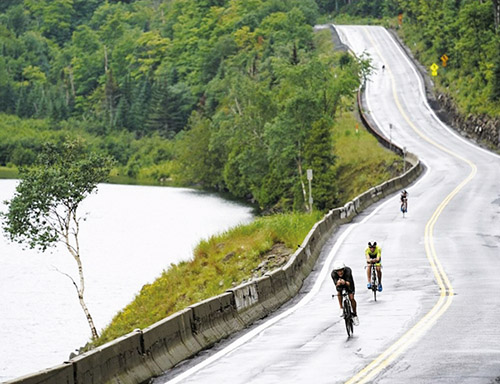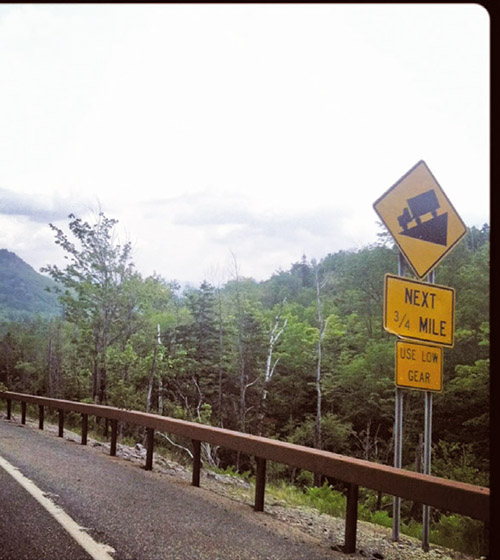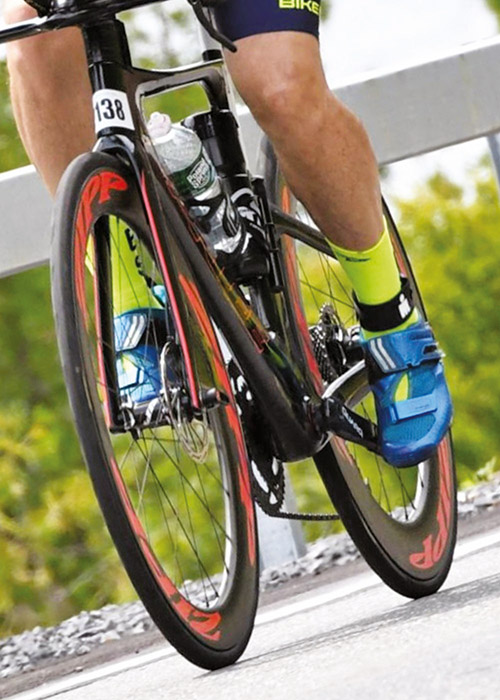
1:27 p.m. (5.75 hours since race start)
Racing is about challenging yourself to do the “hard” thing and find that you have within you the ability to do things you didn’t think you could … in my case, things you were scared of. On this second loop, I shelved my fear, focused my eyes on the road in front of me and I pedaled as fast as I could to start my descent on Keene. At the beginning of the descent there are three yellow signs that warn riders for the “Next ¾ mile, use low gear,” but those words don’t do justice to the challenge that lies beyond the sign they are printed on.
When I raced Ironman Lake Placid in 2021 my front wheel started to wobble on this descent when the bike reached 40 miles per hour. That year I limited myself to 42 miles per hour, holding on for dear life as the bike vibrated for a mile and a half down the road. I felt like Han Solo in “Star Wars” when he told his ship to “hold together.” I had a post-race conversation with Joe LoPorto at FitwerxNJ, the man who built my bike.

It was the style of the front wheel that created vibrations at speeds over 40 mph. I was chasing my 2016 record of 46 miles per hour. I didn’t feel like changing my wheel set just for one road,
but I also want to reach the bottom of this mountain while still riding my bike, so I accepted the limitation of physics. This year on the first loop I had expected the vibrations to return, but they didn’t. I can only guess that this year was smoother due to a lack of crosswinds. My first descent peaked at 42 miles per hour. When I reached the bottom at the end of the first, I realized that I needed to go for it on the second loop. There’s a point on a descent where pedaling becomes obsolete. You are in your highest gear, but you feel zero resistance when you pedal because the wheels are rotating faster than you can pedal. That is the point where the machine becomes the glider. You are just coasting with the sun on your face and the bottom of the mountain is miles down the road from you.

It was also the moment when I remembered that those 25-millimeter-wide tires were heating up due to the increase in speed.
(How much heat is created at speeds over 40 mph?)
Between 150-180oF, which is why I’m grateful that there is no glue involved.
(Glue?)
There’s a story about a rider on the Tour de France whose tire glue melted on a descent like this one due to the heat coming off the road in the summer sun.
(You don’t use glue, do you?)
No, my tires are what are called clinchers. They attach to the bike wheels by hooking under the lip of the wheel.
One third of the way down the mountain the bike reached 47 mph. This was a new record for me, but I only had a split second to look. I had to watch the road. The next time that you are driving, say 45-50 mph, notice just how fast the objects outside your window go by. Then remind yourself, “David had to balance on two wheels.”
(Ok, wait. Stop the narrative. What does 47 mph feel like when you are riding on 25 millimeters of rubber?)
It is exciting and terrifying. I could feel the flesh of my cheeks rippling in the wind. My eyes, hidden behind sunglasses, squinted in an effort to focus on everything in front of the bike.
Yet, I heard nothing. The world was silently passing behind me. Only when I turned slightly to the left or right did I hear the wind whooshing past me. It is the sound you hear when you put a shell to your ear at the sea.
(Isn’t that just your own pulse echoing back at you?)
This speed required all of my mental and physical energy. For the next five minutes, 300 seconds, every decision had to be perfect. There were slower riders in front of me who were in the passing lane. I didn’t want to slow down and I didn’t want to move over to the incoming traffic lane to get around them. Add to that the fact that the road is not straight. It curses, so you have to lean into the curve hoping that your tires keep gripping the asphalt. I had to time my pass perfectly or someone was going to get very hurt at these speeds.
David Roher is a USAT certified triathlon and marathon coach. He is a multi-Ironman finisher and veteran special education teacher. He is on Instagram @David Roher140.6.
He can be reached at TriCoachDavid@gmail.com.











